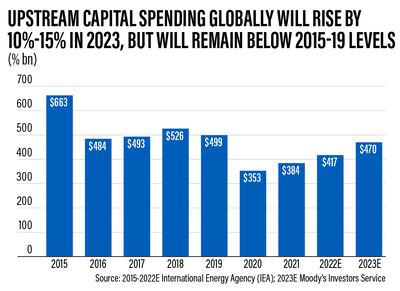The oilfield services sector in the Europe, Middle East and Africa region is set to benefit from a rise in upstream capital spending by crude producers this year amid efforts to boost production, Moody’s Investors Service has said.
Global energy businesses and national oil companies (NOCs), especially in the Middle East, are increasing spending as higher crude prices provide incentives to develop their hydrocarbon reserves, Moody’s said in a report on Tuesday.
“The supply/demand imbalance in the oil and gas market and the increase in oil prices since the middle of 2021 have prompted international oil companies as well as NOCs to increase their investments to close this supply gap,” Moody’s analysts said.
The imbalance in the market has been building up since 2017 and a series of shocks, including the Russia-Ukraine war, caused oil prices to climb sharply last year.
Prices of Brent, the benchmark for more than two thirds of the world’s oil, rose to a notch under $140 per barrel but gave up most gains towards the end of last year.
Brent is currently trading near $75 per barrel amid a weaker economic outlook that has triggered demand concerns.
“Although Brent prices have dropped in 2023 to an average of $82 per barrel down from above $100 per barrel in 2022, we expect that at these prices OFS [oilfield equipment and services] activity will remain healthy,” Moody's said.
Although prospects for the OFS sector in the Europe, Middle East and Africa region look strong for “the next 12 to 18 months”, providers will have to contend with a “high inflationary environment, supply chain disruptions as well as uncertainties surrounding geopolitical risk and global economic growth that drive oil price volatility”, Moody’s analysts said.
Global upstream investment that peaked at $663 billion in 2015, plummeted to $353 billion in 2020, as oil and gas demand and prices slumped in the second quarter of the year after the Covid-19 pandemic led to lockdowns around the world.
Investments have since gradually recovered, climbing to $384 billion in 2021 and an estimated $417 billion last year, Moody’s said, citing data from the International Energy Agency.

It expects upstream capital investments globally to increase by 10 per cent to 15 per cent this year to about $470 billion, still below the 2015 to 2019 levels of capital expenditure.
Annual upstream investment in oil and gas will need to reach $640 billion in 2030 to ensure adequate supplies, the International Energy Forum and S&P Global Commodity Insights said in a report in February.
S&P, which estimated $499 billion of investments in the upstream sector in 2022, said the new estimate was about 18 per cent higher than the previous prediction, “primarily because of rising costs”.
A cumulative investment of $4.9 trillion will be needed between this year and 2030 to meet market needs and prevent a supply shortfall, even if demand growth slows towards a plateau, the S&P report said.
Moody’s expects demand for services from OFS companies in the region to remain robust this year as international companies and NOCs increase capital spending in a continued effort to step up production capacity.
“This is especially the case for many of the GCC-based NOCs, such as Aramco, Abu Dhabi National Oil Company and QatarEnergy, which is driving an expansion in offshore drilling activity and increasing demand for jackup rigs,” Moody’s said.
“All GCC-based NOCs have raised their production since the second quarter of 2021 in response to growing demand for oil, as many governments globally started to relax some of the Covid-related restrictions they had imposed at the start of the pandemic."
Oil production in Saudi Arabia increased to above pre-pandemic levels last year, while in Kuwait and the UAE, it rose in line with pre-pandemic levels, Moody's said.
Last year, Adnoc approved a Dh550 billion ($150 billion) budget for the next five years. The company’s board endorsed plans to bring forward the expansion of Adnoc’s production capacity, currently at five million barrels per day (bpd), to 2027, from the previous target of 2030.
Aramco, the biggest oil exporting company in the world, boosted its capital expenditure by 18 per cent to $37.6 billion last year.
The Riyadh-listed global oil company plans to raise crude oil production to 13 million bpd by 2027 and potentially increase gas production by more than 50 per cent by 2030 as part of its growth strategy.
QatarEnergy is expected to increase its liquefied natural gas production by 60 per cent by 2027 from 2020 levels.
The large capital spending programmes by NOCs are also driving demand for jackup rigs in the GCC region, Moody’s said.
“GCC NOCs' strong operating performance, underpinned by a solid recovery of oil demand in 2021 and 2022, will continue to support long-term rig renewals led by Aramco,” Moody’s analysts said.
“We foresee continued growth in the contracted rig count in the GCC region this year following a jump to 131 rigs in 2022 from 115 in 2021.”
Drilling companies in the region are also investing in expanding their fleet of rigs to help NOCs meet their production targets.
This month, Adnoc Drilling, the largest national drilling company in the Middle East by rig fleet size, signed an agreement to purchase 10 new-build hybrid-powered land drilling rigs for $252 million.
“Increased demand for OFS will enable the companies to improve their liquidity as well as reduce debt levels,” Moody’s said.


